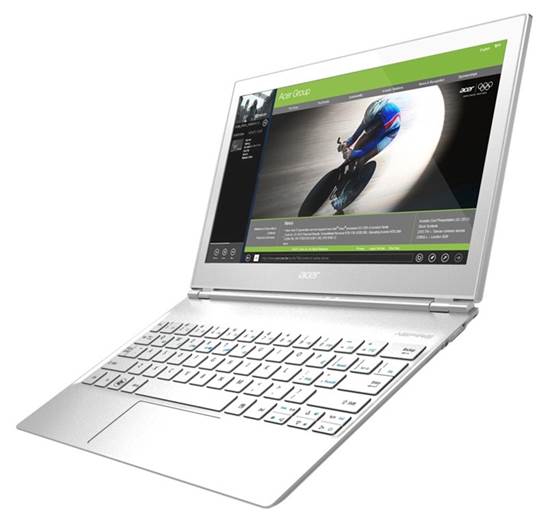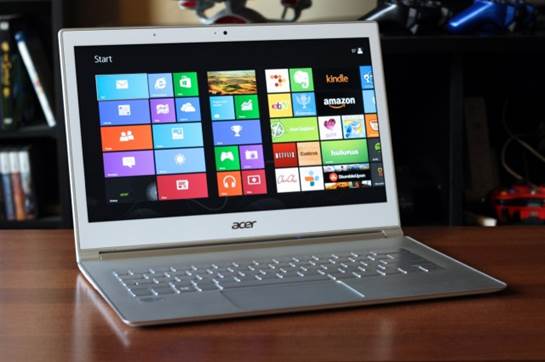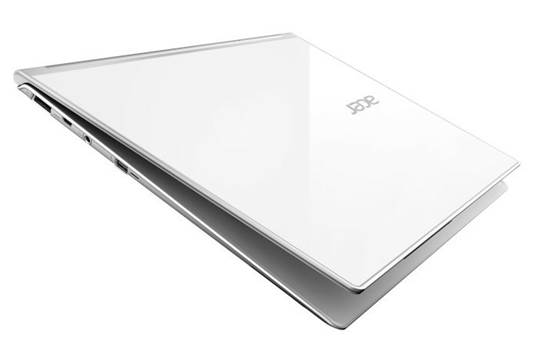As if the Acer s7's seductively slim figure
and supremely good looks weren’t enough, this skinny vixen of a portable also
boasts an impressive performance acumen. It must drive the competition crazy.
Setting a new standard in svelte, the
13-inch S7 measures less than a half-inch at its thickest and its carry weight
comes in under three pounds. As a result, it’s nearly effortless to tote
around. And tote it around you will, if you’re a sucker for admiring glances.
Besides attracting attention with its pancake-flat form factor, the S7 sports a
striking glossy-white lid made of Gorilla Glass, for the dual purpose of
durability and style. A simple Acer logo glows blue when the S7 is powered on.

Acer's
Aspire S7 Ultrabook
When open, the S7’s elegant anodized
aluminum interior, backlit keyboard, and glass touchpad steal the show. As does
its IPS screen, which features a precedent-setting 1920x1080 res at least, it’s
a first among the Ultrabooks we’ve tested. Images look sharp and vibrant from
any angle, although the screen’s glossy surface inevitably picks up the glare
of environmental light.
In use, the Chiclet keyboard is extremely
shallow, with minimal travel, but that’s an inevitable consequence of the
notebook’s ultra-low profile. It took us just a little while to get used to the
feel, and the size and spacing of the keys are suitable for serious typing. The
touchpad, while extremely smooth, is made by Elan Microelectronics and felt
slightly laggy compared to Synaptics-powered pads. Anyway, you’ll likely be
performing many of these functions via the highly responsive 10-point
touchscreen.

In
use, the Chiclet keyboard is extremely shallow, with minimal travel, but that’s
an inevitable consequence of the notebook’s ultra-low profile.
Lest you think the S7’s beauty is all on
the surface, take a gander at the benchmarks. Yes, this is the first Ultrabook
we’ve tested to top the scores of our Intel reference zero-point. Intel’s UB
has had a distinct advantage in not being a shipping product and thus clocked
more aggressively than the production Ultrabooks we’ve tested. But the S7’s
1.9GHz Core i7-3517U, dual-channel RAM, and pair of 128GB SSDs in RAID 0 gave
it a clear, albeit modest, performance advantage in all of our benchmarks.
Under heavy load, the two small 10,000rpm fans inside the S7 - one to pull in
cool air, the other to push it out-become quite audible, but the machine stays
comfortably cool, with most heat concentrated at the back.

The
spare elegance of the S7’s aluminum interior is complemented by its stylish
white Gorilla Glass display frame and lid.
The only thing tempering our extreme
infatuation with the 57 is its relatively weak battery life. Granted, this
month we switched our rundown test from a looped standard-def video to a ripped
Blu-ray file using VLC, but even so, theS7 only lasted two hours, 40 minutes,
compared to the zero-point’s three hours, 40 minutes under the same conditions.
For a device that’s so clearly made for mobility, this is a disappointment. To
be fair, the S7 is about a third thinner than the reference Ultrabook.

To
be fair, the S7 is about a third thinner than the reference Ultrabook.
We can acknowledge that this thin a device
with this much power is bound to make allowances somewhere. When you toss in
the included carrying case, matching white wireless mouse, and expansion
dongles, the fetching S7 makes a pretty compelling case for its premium price
tag.
|
Specifications
§ CPU:
1.9GHz Core i7-3517U
§ RAM:
4GB DDR3/1333 dual-channel RAM
§ Display:
13.3-inch 1920x1080 IPS LCD
§ Storage:
2x 128GB SSD in RAID 0
§ Connectivity:
2x USB 3.0, Micro-HDMI, headphone/mic input, 2-in-1 card reader, 802.11n,
Bluetooth 4.0, 1.3MP webcam, Micro-HDMI-to-VGA dongle, USB-to-Ethernet Dongle
§ Lap/Carry:
2 lbs, 13.3 oz / 3 lbs, 8 oz
|